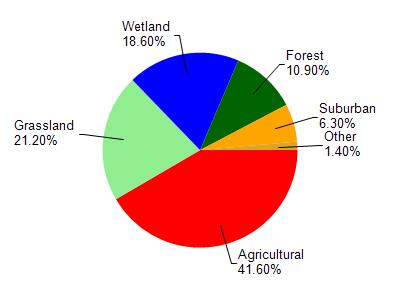Washington
No
No
No
Fish and Aquatic Life
Overview
From its headwaters in a small wetland and agricultural area, the Ashippun River flows at a low gradient (6 ft/mile) southwest through Druid Lake to the Rock River. The water is stained light brown by tannic acid and the bottom is largely silt. An impoundment at Monterey and several structures upstream have created water and fishery qualities similar to those of a lake. Northern pike and bass offer limited fishing. Access is available from seven road crossings.
The 7.5-minute series USGS topographic maps show 12 intermittent and 5 perennial tributaries to the Ashippun River. Information is lacking on water quality, habitat and fisheries for these tributaries. Formal stream classifications are also lacking.
Little is known about the Ashippun River's water quality or whether the river is meeting its full potential. The least darter, a fish on the state's watch or special concern list, has been found in the river's upper reaches (Fago, 1982).
Date 2002
Author Aquatic Biologist
Impaired Waters
Ashippun River (853800) was placed on the impaired waters list in 2014 for total phosphorus. The 2016 assessments showed continued impairment by phosphorus; total phosphorus sample data exceed 2016 WisCALM listing criteria for the Fish and Aquatic Life use, however, available biological data do not indicate impairment (i.e. no macroinvertebrate or fish Index of Biotic Integrity (IBI) scored in the "poor" condition category). This water was also assessed for temperature and sample data did not exceed 2016 WisCALM listing criteria for the Fish and Aquatic Life use. Based on the most updated information, no change in existing impaired waters listing is needed.
Date 2015
Author Aaron Larson
Condition
Wisconsin has over 84,000 miles of streams, 15,000 lakes and milllions of acres of wetlands. Assessing the condition of this vast amount of water is challenging. The state's water monitoring program uses a media-based, cross-program approach to analyze water condition. An updated monitoring strategy (2015-2020) is now available. Compliance with Clean Water Act fishable, swimmable standards are located in the Executive Summary of Water Condition in 2018. See also the 'monitoring and projects' tab.
Reports
Management Goals
Wisconsin's Water Quality Standards provide qualitative and quantitative goals for waters that are protective of Fishable, Swimmable conditions [Learn more]. Waters that do not meet water quality standards are considered impaired and restoration actions are planned and carried out until the water is once again fishable and swimmable
Management goals can include creation or implementation of a Total Maximum Daily Load analysis, a Nine Key Element Plan, or other restoration work, education and outreach and more. If specific recommendations exist for this water, they will be displayed below online.
Monitoring
Monitoring the condition of a river, stream, or lake includes gathering physical, chemical, biological, and habitat data. Comprehensive studies often gather all these parameters in great detail, while lighter assessment events will involve sampling physical, chemical and biological data such as macroinvertebrates. Aquatic macroinvertebrates and fish communities integrate watershed or catchment condition, providing great insight into overall ecosystem health. Chemical and habitat parameters tell researchers more about human induced problems including contaminated runoff, point source dischargers, or habitat issues that foster or limit the potential of aquatic communities to thrive in a given area. Wisconsin's Water Monitoring Strategy was recenty updated.
Grants and Management Projects
Monitoring Projects
| WBIC | Official Waterbody Name | Station ID | Station Name | Earliest Fieldwork Date | Latest Fieldwork Date | View Station | View Data |
|---|
|
|

Watershed Characteristics
Ashippun River is located in the Ashippun River watershed which is 68.70 mi². Land use in the watershed is primarily agricultural (41.60%), grassland (21.20%) and a mix of wetland (18.60%) and other uses (18.60%). This watershed has 108.43 stream miles, 327.41 lake acres and 7,663.77 wetland acres.
Nonpoint Source Characteristics
This watershed is ranked Not Ranked for runoff impacts on streams, Not Ranked for runoff impacts on lakes and High for runoff impacts on groundwater and therefore has an overall rank of High. This value can be used in ranking the watershed or individual waterbodies for grant funding under state and county programs.However, all waters are affected by diffuse pollutant sources regardless of initial water quality. Applications for specific runoff projects under state or county grant programs may be pursued. For more information, go to surface water program grants.